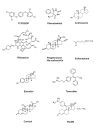CAR and PXR: the xenobiotic-sensing receptors
- PMID: 17284330
- PMCID: PMC1950246
- DOI: 10.1016/j.steroids.2006.12.006
CAR and PXR: the xenobiotic-sensing receptors
Abstract
The xenobiotic receptors CAR and PXR constitute two important members of the NR1I nuclear receptor family. They function as sensors of toxic byproducts derived from endogenous metabolism and of exogenous chemicals, in order to enhance their elimination. This unique function of CAR and PXR sets them apart from the steroid hormone receptors. In contrast, the steroid receptors, exemplified by the estrogen receptor (ER) and glucocorticoid receptor (GR), are the sensors that tightly monitor and respond to changes in circulating steroid hormone levels to maintain body homeostasis. This divergence of the chemical- and steroid-sensing functions has evolved to ensure the fidelity of the steroid hormone endocrine regulation while allowing development of metabolic elimination pathways for xenobiotics. The development of the xenobiotic receptors CAR and PXR also reflect the increasing complexity of metabolism in higher organisms, which necessitate novel mechanisms for handling and eliminating metabolic by-products and foreign compounds from the body. The purpose of this review is to discuss similarities and differences between the xenobiotic receptors CAR and PXR with the prototypical steroid hormone receptors ER and GR. Interesting differences in structure explain in part the divergence in function and activation mechanisms of CAR/PXR from ER/GR. In addition, the physiological roles of CAR and PXR will be reviewed, with discussion of interactions of CAR and PXR with endocrine signaling pathways.
Figures




Similar articles
-
CAR and PXR: xenosensors of endocrine disrupters?Chem Biol Interact. 2005 Aug 15;155(3):111-28. doi: 10.1016/j.cbi.2005.06.003. Chem Biol Interact. 2005. PMID: 16054614 Review.
-
Evolution and function of the NR1I nuclear hormone receptor subfamily (VDR, PXR, and CAR) with respect to metabolism of xenobiotics and endogenous compounds.Curr Drug Metab. 2006 May;7(4):349-65. doi: 10.2174/138920006776873526. Curr Drug Metab. 2006. PMID: 16724925 Free PMC article. Review.
-
Orphan nuclear receptors constitutive androstane receptor and pregnane X receptor share xenobiotic and steroid ligands.J Biol Chem. 2000 May 19;275(20):15122-7. doi: 10.1074/jbc.M001215200. J Biol Chem. 2000. PMID: 10748001
-
Regulation of drug-metabolizing enzymes by xenobiotic receptors: PXR and CAR.Adv Drug Deliv Rev. 2010 Oct 30;62(13):1238-49. doi: 10.1016/j.addr.2010.08.006. Epub 2010 Aug 17. Adv Drug Deliv Rev. 2010. PMID: 20727377 Free PMC article. Review.
-
New insights on the xenobiotic-sensing nuclear receptors in liver diseases--CAR and PXR--.Curr Drug Metab. 2008 Sep;9(7):614-21. doi: 10.2174/138920008785821666. Curr Drug Metab. 2008. PMID: 18781913 Review.
Cited by
-
Characterization of peroxisome proliferator-activated receptor alpha--independent effects of PPARalpha activators in the rodent liver: di-(2-ethylhexyl) phthalate also activates the constitutive-activated receptor.Toxicol Sci. 2010 Jan;113(1):45-59. doi: 10.1093/toxsci/kfp251. Epub 2009 Oct 22. Toxicol Sci. 2010. PMID: 19850644 Free PMC article.
-
Role of vitamin D receptor in the regulation of CYP3A gene expression.Acta Pharm Sin B. 2019 Nov;9(6):1087-1098. doi: 10.1016/j.apsb.2019.03.005. Epub 2019 Apr 4. Acta Pharm Sin B. 2019. PMID: 31867158 Free PMC article. Review.
-
Minireview: role of orphan nuclear receptors in cancer and potential as drug targets.Mol Endocrinol. 2014 Feb;28(2):157-72. doi: 10.1210/me.2013-1291. Epub 2013 Dec 2. Mol Endocrinol. 2014. PMID: 24295738 Free PMC article. Review.
-
Activation of the steroid and xenobiotic receptor, SXR, induces apoptosis in breast cancer cells.BMC Cancer. 2009 Jan 5;9:3. doi: 10.1186/1471-2407-9-3. BMC Cancer. 2009. PMID: 19123943 Free PMC article.
-
Nonalcoholic fatty liver disease: molecular pathways and therapeutic strategies.Lipids Health Dis. 2013 Nov 9;12:171. doi: 10.1186/1476-511X-12-171. Lipids Health Dis. 2013. PMID: 24209497 Free PMC article. Review.
References
-
- Kodama S, Negishi M. Phenobarbital confers its diverse effects by activating the orphan nuclear receptor CAR. Drug Metab Rev. 2006;38:75–87. - PubMed
-
- Sueyoshi T, Negishi M. Phenobarbital response elements of cytochrome P450 genes and nuclear receptors. Annu Rev Pharmacol Toxicol. 2001;41:123–43. - PubMed
-
- Swales K, Kakizaki S, Yamamoto Y, Inoue K, Kobayashi K, Negishi M. Novel CAR-mediated mechanism for synergistic activation of two distinct elements within the human cytochrome P450 2B6 gene in HepG2 cells. J Biol Chem. 2005;280:3458–66. - PubMed
-
- Qatanani M, Zhang J, Moore DD. Role of the constitutive androstane receptor in xenobiotic-induced thyroid hormone metabolism. Endocrinology. 2005;146:995–1002. - PubMed
-
- Maglich JM, Watson J, McMillen PJ, Goodwin B, Willson TM, Moore JT. The nuclear receptor CAR is a regulator of thyroid hormone metabolism during caloric restriction. J Biol Chem. 2004;279:19832–8. - PubMed
Publication types
MeSH terms
Substances
Grants and funding
LinkOut - more resources
Full Text Sources
Other Literature Sources
Molecular Biology Databases

